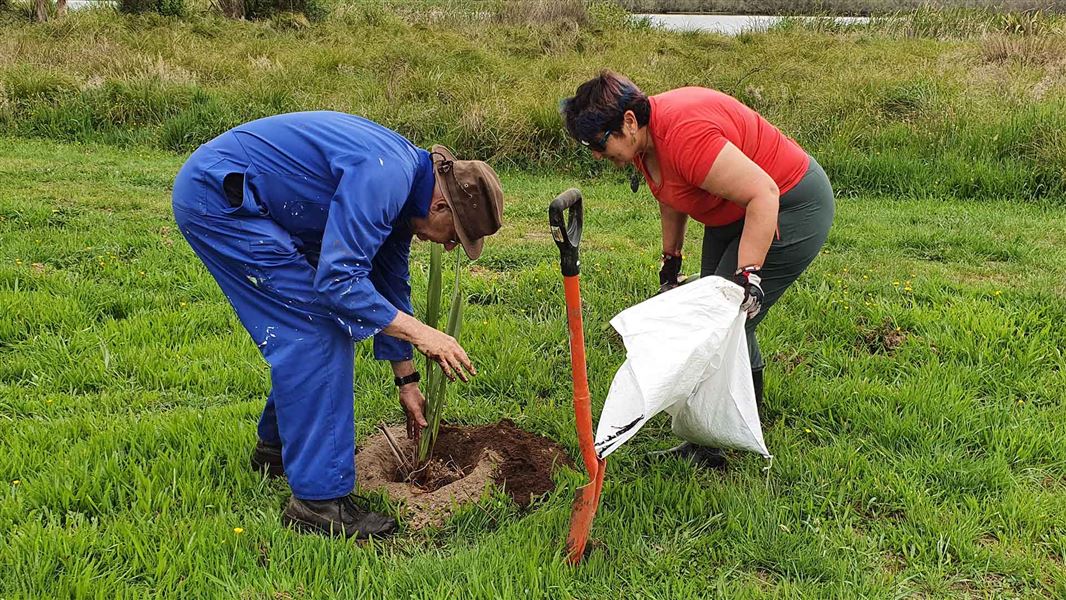
Archived content: This media release was accurate on the date of publication.
Introduction
Thirty-five flax plants have been replanted at Waikato’s Lake Ruatuna as part of a project to establish a nursery for the sought-after weaving material.Date: 05 November 2020
The flax, from 11 different varieties, are significant to Māori weavers and have been translocated from a private property on the outskirts the Hamilton.
The specimens – ruahine, whareongaonga, wharariki, tūtaewheke, taiore, atarau, wharanui and tukura - were from the collection of local weaver Penney Cameron, who had obtained them over several years. Kohunga specimens were also provided by weaver Janaya Christie.
Living Water staff approached Penny Cameron for assistance to develop the pā harakeke – a garden-style selection of flax varieties for use in weaving - at Lake Ruatuna, where several agencies are involved in a long-term ecological restoration.
Dion Patterson, Senior Biodiversity Ranger for DOC, says introducing rare flax varieties to the Lake Ruatuna Living Water project had always been part of the plan after a visit by weavers from Ngāti Apakura.
“A key part of our work at Lake Ruatuna is mātauranga Māori – put simply, ensuring Māori knowledge and culture is reflected at this site – and the craft of weaving and cultivating the materials is a vital part of that,” he says.
Living Water and its partners have spent the last year preparing the site, aware of the cultural significance of translocating prized flax species. Work has involved the removal of introduced pest plant species, creation of a walking track, and contouring of the area for the pā harakeke.
The translocation occurred last week, with Ngāti Apakura representatives and Penney Cameron in attendance to work alongside Living Water staff to get the special plants into the ground.
“We were very pleased to reach this milestone. There was some real excitement about this work – everyone involved could sense it was the culmination of a lot of effort, planning and relationship building,” Dion Patterson says.
The flaxes planted are small cuttings – less than 1 metre tall – and will take approximately several years to grow to a size when they can be harvested for weaving, or be divided and planted elsewhere to sustain thevarieties.
“These flaxes aren’t fast-growing varieties,” Dion Patterson says. “And although the wetland is a suitable environment for these flaxes generally, several varieties aren’t widely found in the Waikato.”
Penney Cameron says the flaxes were originally obtained from the National New Zealand Flax Collection - Te Kohinga Harakeke o Aotearoa - at Manaaki Whenua’s Lincoln site. The varieties were originally from the Renee Orchiston collection, which was compiled over several decades before it was put into the care of Manaaki Whenua.
“It’s great we’ve been able to get some into the soil at Lake Ruatuna,” she says.
One variety, wharanui, has its origins in Te Urewera, and is an uncommon golden colour. It was Tūhoe’s preferred flax for wraps used for keeping babies and young children warm.
“This flax is growing beyond its usual mountain habitat, so it will be particularly interesting to see how it takes to the different conditions at Lake Ruatuna – it’s my favourite, and I’m very keen to see how it goes,” Penney Cameron says.
Ngāti Apakura’s Rama Kete – a highly regarded weaver and tutor who taught at Wintec– was contacted by Manaaki Whenua’s Mahuru Wilcox to contribute advice and guidance.
Rama Kete says one of the major bonuses of the site is it ensures student weavers at TWOA have easy access to a range of resources, all in one location.
“I just looked at it from a weaver’s point of view,” she says. “We’ve ticked a lot of boxes with Lake Ruatuna – there’s heaps of space, the access is easy, and the weavers can obtain their materials at the site and start weaving right there at the campsite.”
Rama Kete says the weavers will need to be patient while they wait for the plants to mature.
Several tree species significant to Māori medicine have also been planted as part of the translocation work.
It is intended to develop an education trail at the site so visitors can learn about the importance of these plant and tree species for matauāranga Māori.
Lake Ruatuna is an important site for DOC’s Living Water partnership with Fonterra, with several trials underway to determine how farmers can implement measures to limit their impact on waterways near their properties.
Work at Lake Ruatuna is often undertaken by offenders serving community sentences with the Department of Corrections, through the Good to Grow partnership with DOC. Sections of land at the site are owned by Waipa District Council.
Contact
For media enquiries contact:
Email: media@doc.govt.nz